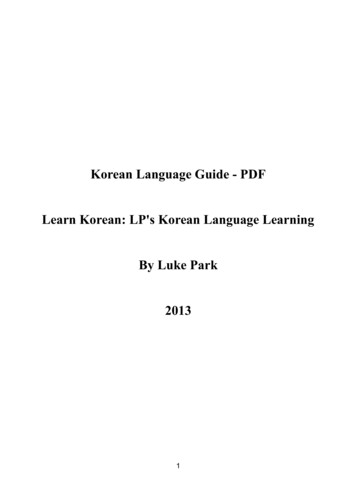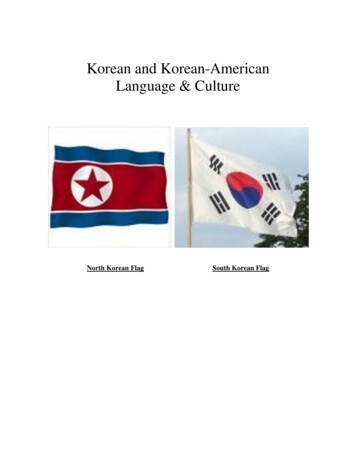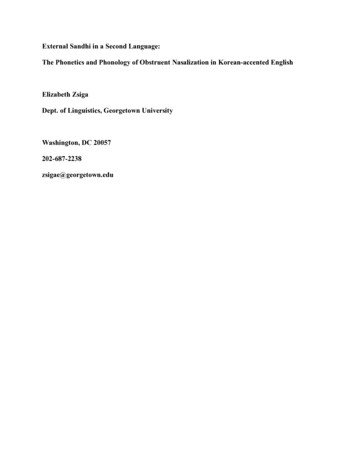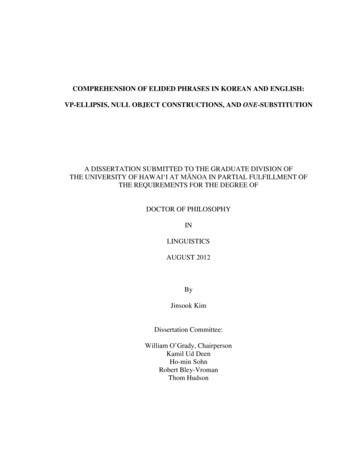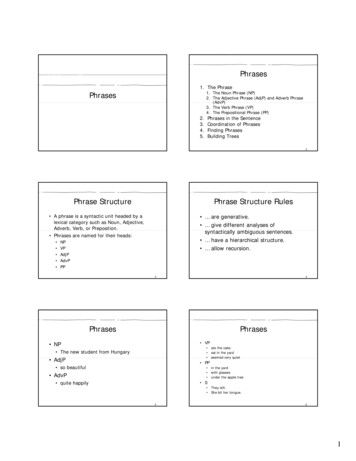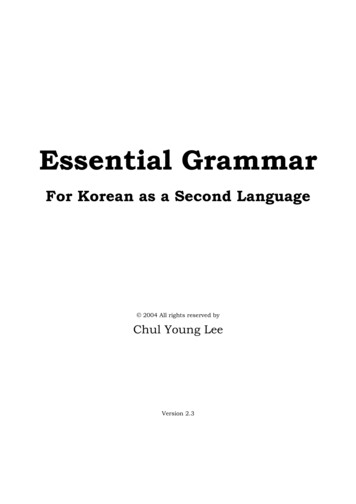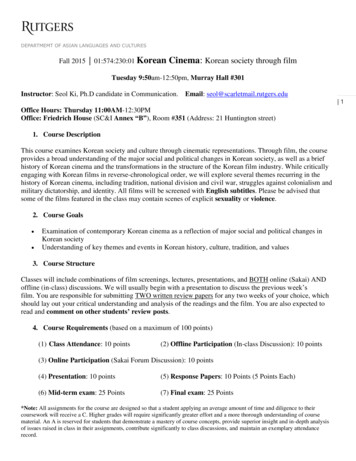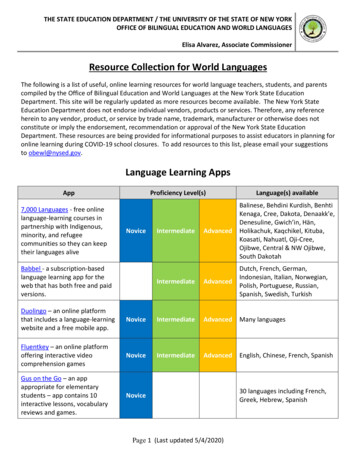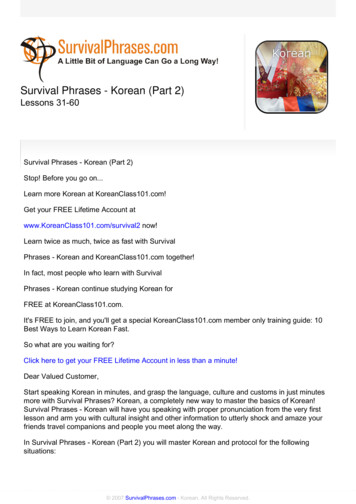
Transcription
Survival Phrases - Korean (Part 2)Lessons 31-60Survival Phrases - Korean (Part 2)Stop! Before you go on.Learn more Korean at KoreanClass101.com!Get your FREE Lifetime Account atwww.KoreanClass101.com/survival2 now!Learn twice as much, twice as fast with SurvivalPhrases - Korean and KoreanClass101.com together!In fact, most people who learn with SurvivalPhrases - Korean continue studying Korean forFREE at KoreanClass101.com.It's FREE to join, and you'll get a special KoreanClass101.com member only training guide: 10Best Ways to Learn Korean Fast.So what are you waiting for?Click here to get your FREE Lifetime Account in less than a minute!Dear Valued Customer,Start speaking Korean in minutes, and grasp the language, culture and customs in just minutesmore with Survival Phrases? Korean, a completely new way to master the basics of Korean!Survival Phrases - Korean will have you speaking with proper pronunciation from the very firstlesson and arm you with cultural insight and other information to utterly shock and amaze yourfriends travel companions and people you meet along the way.In Survival Phrases - Korean (Part 2) you will master Korean and protocol for the followingsituations: 2007 SurvivalPhrases.com - Korean. All Rights Reserved.
Taking a taxi without being taken advantage of Getting around and asking directions and understanding the answer! Learning Korean using Korean and make lots of friends Making the most of a hotel stay, and exploring alternatives to the beaten path Visiting the Post Office and mailing thing home Phone cards and phone rentals, don't travel without this! Critical phrases for vegetarians and allergy suffers! Talking to the doctor and explaining symptoms correctly Getting the right medicine Expressing yourself with adjectives and being understood Home visits and proper protocol that will "wow" hosts Getting help, this lesson may be the most useful phrase you ever learnBe sure to read the lessons for additional tips and information that will make learning Korean andKorean culture even more interesting.Best regards,Survival Phrases - Korean p.s. Don't miss out! Go to KoreanClass101.com/survival2 and sign up for your free lifetimeaccount and keep learning Korean.p.p.s. Survival Phrases for all your travel needs! Survival Phrases is available in more than 14languages. The perfect series for mastering the basics. Visit SurvivalPhrases.com to learn moreabout our languages. 2007 SurvivalPhrases.com - Korean. All Rights Reserved.
Lesson 31: Please Take My Picture사진 찍어 주세요 (sajin jjikeo juseyo)LESSON NOTESIn today’s lesson we’ll introduce a phrase that is certain to come in handy for capturing yourmemories on film. Korea is full of beautiful scenery, and there are times when you’ll want to bein the picture or have everyone in your party in the picture. Therefore, there are times when thephrase, “Please take my/our picture” will be invaluable!The phrase "Please take my picture" in Korean is "sajin jjikeo juseyo" (사진 찍어 주세요). Thefirst word is "sajin" (사진). This word means "picture," or "photograph." The next word is "jjikeo"(찍어). This word literally means "print," or "stamp." But in this context it gives off the impressionof snapping a picture. It's the verb used when taking a picture. Last is the, oh so important,"juseyo" (주세요). This is generally interpreted as "please." Altogether the phrase is "sajin jjikeojuseyo," which literally means "picture, snap, please." This can be translated as "Please take apicture for me." "For me" is inferred here because "juseyo" requests a favor from someone.Now in English, before someone takes a picture, the person taking the picture may say, “1, 2, 3.Cheese.” In Korean before a picture is taken, the person taking the picture may say "hana, dul,set. kimchi" (하나, 둘, 셋 김치). It may be a little cliche, but it is used every so often. "One,two, three" in Korean is "hana, dul, set" (하나, 둘, 셋). The last part of the phrase is "kimchi"(김치).PHRASESHangul사 진 찍 어 주 세 요.하 나, 둘, 셋. 김 치.Romanizedsajin jjikeo juseyo.hana, dul, set. kimchi.EnglishPlease take my/our picture.One, two, three. cheeseHangul사 진.찍 다 ( 찍 어).Romanizedsajin.jjikda (jjikeo).주 다 ( 주 세 요).하 나.둘.juda (juseyo).hana.dul.EnglishPicture.To print, to stamp (to take apicture, or snap a photo).To give (please).One.Two.VOCABULARY 2007 SurvivalPhrases.com - Korean. All Rights Reserved.
Hangul셋.김 치.Romanizedset.kimchi.EnglishThree.Kimchi.QUICK TIPIn Korea, there are these booths that can take pictures of you and your friends. These are muchlike passport photo booths. But unlike the passport photo booths, these booths can take picturesthat also double as stickers. In addition to that, they can include decorations, backdrops, andthemes in your pictures. First, insert some money (just like an arcade game). After you enter thebooth, you'll be greeted with options for pictures. You can choose themes such as a hauntedhouse, or space travel, just to name a few. Then the pictures are taken. After the pictures aretaken, you are given more options. You can draw onto your picture with a variety things. After allis done, you simply need to wait for it to print.The cost of these pictures start from around 5,000 won. 2007 SurvivalPhrases.com - Korean. All Rights Reserved.
Lesson 32: May I Take Your Picture?사진 짝어도 돼요? (sajin jjikeo-do dwaeyo?)LESSON NOTESIn today’s lesson we’ll introduce a question related to “Can you take our/my picture?” which inKorean is "sajin jjikeo juseyo" (사진 찍어 주세요). This phrase asks someone to take a picturefor you, or of you. But there are cases when you may want to take a picture of someone or withsomeone, but before doing so, you’d like to ask for permission.In Korean “May I take your picture?” is "sajin jjikeo-do dwaeyo" (사진 찍어도 돼요?). The firstword is "sajin" (사진), which means picture. This is followed by "jjikeo" (찍어), which in Englishis to take or snap a picture. So to recap so far, we have "sajin, jjikeo" (사진 찍어), which literallymeans "picture, take" or "picture, snap." The last part of the phrase is "do dweyo" (도 돼요),which means “may I.” "Do dwaeyo" is a grammatical structure used when asking someone forpermission. So all together the phrase is "sajin jjikeo-do dweyo" (사진 찍어도 돼요). Literally thephrase is "picture, take, may I." In English this would be, "May I take your picture."Now let’s take that last phrase and step it up a notch. By adding one word you can ask someoneif you can take a picture together. The phrase once again is "sajin jjikeo-do dwaeyo?" (사진찍어도 돼요?). Now to slightly alter the phrase. To do this, we can insert the word "together,"which in Korean is "gati" (같이). If we add "together," or "gati" to the front of the phrase we justlearned, it changes the meaning of the phrase. Instead of "May I take your picture?" the phrasenow means "May I/we take a picture with you?" The phrase we would have here is "gati sajinjjikeo-do dwaeyo?" (같이 사진 찍어도 돼요?). Literally the phrase here is "together, picture, take,may I?" This phrase is interpreted as "May I take a picture with you?" or "May I/we take a picturetogether with you?"PHRASESHangul사 진 찍 어 도 돼 요?Romanizedsajin jjikeo-do dwaeyo?같 이 사 진 찍 어 도 돼 요?gati sajin jjikeo-do dwaeyo?EnglishMay I take your picture? May Itake a picture of you?May I/we take a picture withyou? 2007 SurvivalPhrases.com - Korean. All Rights Reserved.
VOCABULARYHangul사 진.찍 다 ( 찍 어).Romanizedsajin.jjikda (jjikeo). 도 되 다 ( 도 돼 요)같 이. do dwaeda ( do dwaeyo)gati.EnglishPicture.To take a picture (snap, print,stamp)May I Together.QUICK TIPAs mentioned in the mp3, picture culture in Korea is based on cuteness. The "peace signs" areomnipresent in pictures. In addition, sticker picture booths provide you with graphics to pretty upyour pictures. However, a good number of Koreans don't need a sticker booth to enhance theirpictures. Many Koreans are amateur Adobe Photoshop operators. Many people are very adeptat altering their own pictures to make each and every picture look as good as possible. Manypeople take their amateur skills and turn it into a profession. Graphic design work is a popularnext step for many amateur Korean photo croppers. 2007 SurvivalPhrases.com - Korean. All Rights Reserved.
Lesson 33: How Do I Say This in Korean?한국말로 어떻게 말해요? (hangukmal-lo eotteokemalhaeyo?)LESSON NOTESIn today’s lesson we’ll introduce you to a phrase that will provide you with the tools to learn fromthe people around. Now, a dictionary is a great idea, but don’t forget that you can use Korean tolearn in a more fun and interactive way.In Korean “How do you say it in Korean?” is "hangukmal-lo eotteoke malhaeyo" (한국말로 어떻게말해요?). The first word "hangukmal" (한국말) means "Korean," as in the Korean language. Thisis followed by "-lo" (로). "Lo" is a particle which can be loosely translated as "in." What we haveso far is "hangukmal-lo" (한국말로), which can be translated as "in Korean." The next part of thephrase is "eotteoke" (어떻게). This means "how." And lastly we have "malhaeyo" (말해요), whichmeans "to say," or "to speak." Literally the phrase "hangukmal-lo eotteoke malhaeyo" means"Korean, in, how, say." This can be translated as "How do you say it in Korean?"Now the most rudimentary way to ask this question is to say this phrase with the word "this." Theword for "this" in Korean is "igeo" (이거). Simply place "this" in front of the phrase "How do yousay I say it in Korean?" The phrase we now have is "igeo hangukmal-lo eotteoke malhaeyo?"(이거 한국말로 어떻게 말해요?). This phrase literally means "this, Korean, in, how, say." This istranslated as "How do you say this in Korean?"Now if there's a specific English word you want to know, you can simply replace "this" or "igeo,"with the English word you want to know. For example if we wanted to know the word "water," wecan simply say "'Water' hangukmal-lo eotteoke malhaeyo?" ('Water' 한국말로 어떻게 말해요?).This is literally "water, Korean, in, how, say?" This is translated as "How do you say 'water' inKorean?"Remember, what you want to know comes in front of the phrase.PHRASESHangul한 국 말 로 어 떻 게 말 해 요?이 거 한 국 말 로 어 떻 게 말 해요?'Water' 한 국 말 로 어 떻 게 말 해요?Romanizedhangukmal-lo eotteokemalhaeyo.igeo hangukmal-lo eotteokemalhaeyo.'Water' hangukmal-loeotteoke malhaeyo.EnglishHow do you say it in Korean?How do you say this inKorean?How do you say 'water' inKorean? 2007 SurvivalPhrases.com - Korean. All Rights Reserved.
oke.malhada (malhaeyo).igeo.EnglishKorean.In (particle).How.To say, to speak.This.VOCABULARYHangul한 국 말.- 로.어 떻 게.말 하 다 ( 말 해 요).이 거.QUICK TIPAs stated many times before, Korea is a group centered society. And as strangers aren't apart of anyone's inner circle, breaking that circle is hard for many Koreans to do. As a result,conversations among strangers are not very common. It's difficult for Koreans to talk to strangersas they simply are not used to it. In addition, many Koreans are shy. Which may make it a bitintimidating to use this question.But being a foreigner may score you some points. Speaking with foreigners are quite rare inKorea, so many people jump at the opportunity to speak with foreigners. Some foreigners evenget stopped in the streets for some casual conversation (an extremely rare act among Koreans!).Experiences will vary greatly. You'll come across unbelievably friendly Koreans, as well as a fewextremely shy and reserved Koreans. It all depends on where you go and who you meet. 2007 SurvivalPhrases.com - Korean. All Rights Reserved.
Lesson 34: Write it Down, please.써 주세요 (sseo juseyo)LESSON NOTESWriting something down is one of the best ways to preserve someone's learning experience.That's why in today's lesson, we'll go over how to ask someone to write something down for you.In Korean, please write it down is "sseo juseyo" (써 주세요). The first word of the phrase is "sseo"(써). This means write. This word is very similar to the word "stand" in pronunciation. The wordfor "stand" is "seo" (서). The word for "write" is "sseo" (써). The difference between the two wordsis difficult to hear for the untrained ear. And the ability to make the different sounds takes a bit ofpractice.The last part of the phrase is "juseyo" (주세요), which means "give," or in this context, "please."Now this may not be useful for someone who doesn't know how to read Hangul yet. So to covera little more ground, we can ask someone to write it down in the Roman alphabet. This in Koreanwould be "yeongeo bareum-daero sseo juseyo" (영어 바름대로 써 주세요). The first part of thephrase is "yeongeo" (영어). This means "English." What follows that is "bareum" (바름), whichmeans "pronunciation." What follows immediately after that is "-daero" (-대로), which is a particle.This particle translates into something along the lines of "in the way of." And lastly we have thephrase we covered in the first half of the lesson, "sseo juseyo," which means "write, please."Altogether the phrase we have is "English, pronunciation, way, write, please." This is translatedas "Please write it down in English."PHRASESHangul써 주 세 요.영 어 바 름 대 로 써 주 세 요.Romanizedsseo juseyo.yeongeo bareumdaero sseojuseyo.EnglishWrite it down, please.Please write it down inEnglish.Romanizedsseuda (sseo).juda (juseyo).yeongeo.EnglishTo write.To give, (please).English.VOCABULARYHangul쓰 다 ( 써).주 다 ( 주 세 요).영 어. 2007 SurvivalPhrases.com - Korean. All Rights Reserved.
Hangul바 름.- 대 , like (particle).QUICK TIPKorean, at first, may seem like a very confusing language to read. There are 10 vowels, and theyall seemingly look the same (here are the 10 vowels: ㅏ, ㅑ, ㅓ, ㅕ, ㅗ, ㅛ, ㅜ, ㅠ, ㅡ, ㅣ) Theyare all a straight line with one, two, or no lines coming out from them. This is probably the biggesthump to get over. Each of the consonants are, generally speaking, unique-looking.Korean is organized into syllabic blocks. So when you read one block, it'll be one syllable. Andbecause of this, most of the time you can break words or phrases down by syllable. The onlyrequirements for a syllabic block is one consonant and one vowel. That's why reading Koreanbecomes easy for so many people.In middle school, a friend and I were bored in class. So for the advancement of the Koreanlanguage (and to pass the time), I taught him how to read Korean. It took him maybe about 2 or 3class periods to learn, but he got the basics of it down after a day. To this day he still remembershow to read Korean. A little story of inspiration for all you. 2007 SurvivalPhrases.com - Korean. All Rights Reserved.
Lesson 35: How Do You Read This?이거 어떻게 읽어요? (igeo eotteoke ilgeoyo?)LESSON NOTESIn today’s lesson we’ll introduce you to another phrase that will provide you with another toolto learn from the people around. Today were going to work on improving our reading andpronunciation. When you come across a word you can’t read, you can use this phrase to get youranswer!In Korean “How do you read this?” is "igeo eotteoke ilgeoyo?" (이거 어떻게 읽어요?). The firstword "igeo" (이거) means "this." This is followed by "eotteoke" (어떻게), which in English is"how." The last part we have here is "ilgeoyo" (읽어요). This word means "read." Literally thephrase means "this, how, read." This can be interpreted as "How do you read this?"Once you get the reading, you can follow this up with, “What does it mean?”In Korean “What does it mean?” is "museun tteusieyo"(무슨 뜻이에요). The first word "museun"means "what kind (of)." This is followed by "tteut," which in English is "meaning." Lastly we have"ieyo" which is basically equivalent to the English verb "to be." Literally the phrase we have hereis "what kind, meaning, is." This can be interpreted as "What does it mean?"PHRASESHangul이 거 어 떻 게 읽 어 요?무 슨 뜻 이 에 요?Romanizedigeo eotteoke ilgeoyo?museun ddeusieyo.EnglishHow do you read this?What does it mean?Romanizedigeo.eotteoke.ilkda (ilgeoyo).museun.ddeut.ida (ieyo).EnglishThis.How.To read.What kind (of).Meaning.To be.VOCABULARYHangul이 거.어 떻 게.읽 다 ( 읽 어 요).무 슨.뜻.이 다 ( 이 에 요). 2007 SurvivalPhrases.com - Korean. All Rights Reserved.
QUICK TIPIf you know how to read Korean, it won't be too difficult to sound out words. I've seen manypeople who aren't Korean, sing along at a 'noraebang' (Korean style karaoke), without knowingthe meaning of any of the words. This is because reading Korean is fairly easy to learn.But if one wants to master Korean, one of the biggest humps to get over is learning thepronunciation changes. This occurs when the sound value of a consonant from one syllabicblock carries over to the next. There are tons of combinations, and getting them all write canonly be mastered with time. This will be intimidating, but all the phonetic changes make senselinguistically. It simply takes time to get used to these changes. 2007 SurvivalPhrases.com - Korean. All Rights Reserved.
Lesson 36: How Do You Eat This?이거 어떻게 먹어요? (igeo eotteoke meokeoyo?)LESSON NOTESIn Korea there's tons of delicious food. Dishes like galbi and bibimbab are well known, even inother countries. But the way Koreans eat these dishes may be not be so well known. There aredishes like "jjigae" (찌개) which are communal dishes. There is "maeuntang" (매운탕) which is adish thats served with left over raw fish. There's a number of different dishes that have their owneating methods. And in this regard, learning how to ask "How do you eat this?" will prove to beextraordinarily useful."How do you eat this?" in Korean is "igeo eotteoke meokeoyo?" (이거 어떻게 먹어요?). The firstword of the phrase, "igeo" (이거), means "this." What follows "this" is "eotteoke" (어떻게). Thisword means "how." And the last part of the phrase is "meokeoyo" (먹어요). This word means"eat." Altogether the phrase literally means "this, how, eat." This is understood as "How do youeat this?"Now as this phrase only pertains to food, let's alter the phrase a little bit so we can ask a moregeneral question. Let's say you're taking a taekwondo lesson, maybe you're making lotus flowerlamps at a temple, maybe you're trying to pick up some traditional Korean instruments. In any ofthese cases the phrase "How do you do this?" would prove useful.The phrase "How do you do this?" in Korean is "igeo eotteoke haeyo?" (이거 어떻게 해요?).Once again the first word, "igeo," means "this." The word following that is "eotteoke" which isthe same "how." The last part is "haeyo" (해요). This means "to do." Altogether the phrase is"igeo eotteoke haeyo?" Literally this means "this, how, do." This is interpreted as "How do you dothis?"Notice how the only difference between the two phrases is the last part of the phrase. The twophrases are "igeo eotteoke meokeoyo" and "igeo eotteoke haeyo." The only thing that changes is"meokeoyo" (먹어요) and "haeyo" (해요). The words that changed are the words "eat" and "do."One of the craziest things I've ever seen was when I was in Korea. I went to a restaurant withsome family friends. Everything was ordered by my mother's friend, so we had no idea whatwe were in for. The night was good, talking, drinking, eating, and all around general merriness.And that's when it came. On a plate was a live octopus. Eating live octopus supposedly providesstamina and strength. I didn't actually have it, but I'll give it a shot if I get a chance next time. Andthen I'll definitely use the phrase "igeo eotteoke meokeoyo?" 2007 SurvivalPhrases.com - Korean. All Rights Reserved.
PHRASESHangul이 거 어 떻 게 먹 어 요?이 거 어 떻 게 해 요?Romanizedigeo eotteoke meokeoyo?igeo eotteoke haeyo?EnglishHow do you eat this?How do you do this?Romanizedigeo.eotteoke.meokda (meokeoyo).hada (haeyo).EnglishThis.How.To eat.To do.VOCABULARYHangul이 거.어 떻 게.먹 다 ( 먹 어 요).하 다 ( 해 요).QUICK TIPAs many dishes in Korea are communal, it may not sound so appetizing for five or six people to"double dip" their spoons into a single pot of stew several times throughout the night. But thisis actually very common in Korea. People share food all the time, and the Western concept ofone dish per person is the total opposite approach that traditional Korean food takes. TraditionalKorean food usually has one or two main dishes. And in addition to these main dishes are manydifferent side dishes. As this is the case with traditional Korean meals, there can be as manyas 15 different dishes on the table. And all of these dishes are communal. The only thing that issolely an individual's, is the bowl of rice. Everything else is shared. 2007 SurvivalPhrases.com - Korean. All Rights Reserved.
Lesson 37: Spicy or Not Spicy안 맵게 해 주세요 (an maepge hae juseyo)LESSON NOTESIn today's lesson we'll go over all the phrases you need to alter a dish to be suited to your tastebuds. Some people can't live without spiciness, some people would rather deal without it. So forour first phrase, we'll go over how to ask if something is spicy.If you're at a restaurant and see something that looks appetizing, a good way to make sure it fitsor doesn't fit into your general likes and dislikes is to ask "Is this spicy?" This phrase in Koreanwould be "igeo maewoyo?" (이거 매워요?). The first half of the phrase is "igeo" (이거), whichmeans "this." After that comes "maewoyo" (매워요), which means "spicy." This phrase literallymeans "this, spicy." This is translated as "Is this spicy?"After you find out if it's spicy or not, we can ask the staff to adjust the flavor. To say "Don't make itspicy, please" we can use the phrase "an maepge haejuseyo" (안 맵게해 주세요). The first wordof the phrase is "an" (안). This word means "not." What comes after that is the adverbial form ofthe word spicy. That word is "maepge" (맵게). After that we have "hae" (해), which means "do,"but in this context can mean "make." And lastly we have "juseyo" (주세요). This word can betranslated as "please." Altogether the phrase is "an maepge haejuseyo" (안 맵게 해 주세요). Thisis literally "not, spicy, make, please." This can be translated as "Don't make it spicy, please."If you think the dish would be too bland without spices, but don't think you can handle theoriginal dish, we can ask to make it a little spicy. To say "Make it a little spicy, please" we cansay "jogeum maepge hae juseyo" (조금 맵게 해 주세요). This phrase is almost the same as thephrase "Don't make it spicy, please." Only one word has changed. Instead of "an" (안), whichmeans "not," the phrase now uses "jogeum" (조금), which means "little." The rest of the phrasestays the same. So the phrase we now have is "jogeum maepge hae juseyo" (조금 맵게 해주세요). This literally means "little, spicy, make, please" and can be translated as "Make it a littlespicy, please."Lastly, if you're traveling because you love adventure, we have a phrase that'll take your mouthon a trip! That phrase is "aju maepge hae juseyo" (아주 맵게 해주세요), which means "Makeit extremely spicy, please." Here we're using the same phrase; we just replaced "an" (not) and"jogeum" (little). For this phrase, we're using "aju" (아주), which means "extremely." So thephrase we have here is "aju maepge haejuseyo" (아주 맵게 해 주세요). Literally, this means"extremely, spicy, make, please." This is understood as "Make it extremely spicy, please." 2007 SurvivalPhrases.com - Korean. All Rights Reserved.
PHRASESHangul이 거 매 워 요?안 맵 게 해 주 세 요.조 금 맵 게 해 주 세 요.아 주 맵 게 해 주 세 요.Romanizedigeo maewoyo?an maepge hae juseyo.jogeum maepge hae juseyo.aju maepge hae juseyo.EnglishIs this spicy?Don't make it spicy, please.Make it a little spicy, please.Make it extremely spicy,please.Romanizedigeo.maepda (maewo/maepge).an.hada (hae).juda (juseyo).jogeum.aju.EnglishThis.To be spicy.Not.To do (to make).To give (please).Little.Extremely.VOCABULARYHangul이 거.맵 다 ( 매 워/ 맵 게).안.하 다 ( 해).주 다 ( 주 세 요).조 금.아 주.QUICK TIPMost spicy Korean dishes are in the form of a "jjigae" (찌개). "Jjigae" is roughly equivalent to aWestern stew. Much like Western stews there are many "chunks" and "pieces" inside. These"chunks" and "pieces" differ according to the type of "jjigae." Almost all types of "jjigae"areseasoned with chili pepper.The creation of a very popular "jjigae," called "budae jjigae," was directly influenced byAmericans. This "jjigae" has spam, sausages, ramyun noodles, kimchi, and anything andeverything. This "jjigae" was concocted around the time of the Korean war. Korea at the timewas still a third world country, and meat was tough to come by. Whenever Americans sharedtheir spam with their Korean allies, the Korean soldiers would add it to their "jjigae" to add somerare meat to a popular Korean dish. "Budae jjigae" was not part of the armistice treaty, and as aresult, has survived the Korean war. "Budae jjigae" is still very popular among Koreans today. 2007 SurvivalPhrases.com - Korean. All Rights Reserved.
Lesson 38: Hotels체크인 하고 싶어요 (chekeuin hago sipeoyo)LESSON NOTESWhen you're traveling in Korea and you have your hotel booked, you may not be so lucky. Theremay not be any English-speaking staff! So the phrase "chekeuin hago sipeoyo" (체크인 하고싶어요) will prove invaluable. This phrase means "I want to check-in."The first word of this phrase is "chekeuin" (체크인). This word means "check-in." This is theEnglish word, but it is just Koreanized. The latter part of the phrase is "hago sipeoyo" (하고싶어요). This means "want to." So altogether the phrase literally means "check-in, want to." Thisis translated as "I want to check-in."The phrase "I want to check-out" is very similar to our last phrase. That phrase is "chekeuauthago sipeoyo" (체크아웃 하고 싶어요). We just took the last phrase, and replaced "chekeuin"(체크인) with "chekeuaut" (체크아웃), which is the Koreanized version of the English word"check-out." And the latter part of the sentence "hago sipeoyo" (하고 싶어요), again, means"want to."Now if you need a key we can say the phrase "yeolsoe juseyo" (열쇠 주세요). The first part ofthe phrase is "yeolsoe" (열쇠). This means key. The latter part of the phrase is "juseyo" (주세요),which means please. So altogether the phrase literally means "key, please."Now in Korea there may be times when you're traveling and the transportation closes. Maybeyou lost your way and you don't have any place to go. Maybe you're in the rural country-sideand you don't have the courage to knock on someone's door to ask someone if you can stay.But maybe you can gather the courage to ask where a guest house is. Or in Korean "yeogwon"(여권).In case you want to go to a guest house, the phrase "yeogi yeogwon isseoyo?" (여기 여권있어요?) may prove useful. This phrase means is there a guest house around here?The first word is "yeogi" (여기), which means here. The next is "yeogwon" (여권). This meansguest house. And last is "isseoyo" (있어요) This means to exist, or when translated, is. Soliterally the phrase is here, "guesthouse, is" This can be translated as "Is there a guest housearound here?"Now a Korean style guest house will provide you with all that comes with a hotel. A room, ashower, and sometimes a bed. Sometimes you may get a mat to sleep on, and traditional Koreanstyle blankets and all that good stuff. But you may also get a heart shaped bed. This is because a"yeogwon" (여권) can double as love-hotel. It's just a cheap place for. lover's to stay. 2007 SurvivalPhrases.com - Korean. All Rights Reserved.
But when I say cheap, I mean. cheap! I stayed at a "yeogwon" (여권) in Busan for 3 nights. AndI ended up paying around 30,000 won. Which is roughly equivalent to 30 american dollars. So ifyou're strapped for cash, "yeogwon" (여권) is the way to go!PHRASESHangul체 크 인 하 고 싶 어 요.체 크 아 웃 하 고 싶 어 요.열 쇠 주 세 요.여 기 여 권 있 어 요?Romanizedchekeuin hago sipeoyo.chekeuaut hago sipeoyo.yeolsoe juseyo.yeogi yeogwon isseoyo?EnglishI want to check-in.I want to check-out.Please give me a key.Is there a guest-house aroundhere?Romanizedchekeuin.chekeuauthago sipda (hago sipeoyo).yeolsoe.juda (juseyo).yeogi.yeogwon.itda (isseoyo).EnglishCheck-in.Check-out.I want to.Key.To give (please).Here.Guest-house.To exist (is).VOCABULARYHangul체 크 인.체 크 아 웃.하 고 싶 다 ( 하 고 싶 어 요).열 쇠.주 다 ( 주 세 요).여 기.여 권.있 다 ( 있 어 요).QUICK TIPYeogwon (여권) is a cheap and very affordable place to stay in Korea. Every town and city inKorea has these. But they aren't exactly the cleanest places to stay. And some people mayactually try to con you out of your money.My experience with a "yeogwon" (여권) was not the greatest. The lady running the guest-housetold us when we were checking out, that we needed to pay some extra money, for unspecifiedreasons. We politely refused, and went on our way. But she followed us and kept threatening tocall the police if we didn't pay up. So I told her to do just that, but she was full of empty threats.I ended up getting into an argument with her, and I guess I ended up winning because she hadconceded and decided not to call the police.So when in Korea, be careful of shady guest-house owners!QUICK TIP 2Also, when in a guest-house in Korea, be sure to not leave valuables in your room. The ownerswill go in to clean, but just like in any country, you can't trust everybody. So be sure to bring yourvaluables along with you when you leave your room. 2007 SurvivalPhrases.com - Korean. All Rights Reserved.
Lesson 39: Post Office 1이거 뉴욕으로 보내고 싶어요 (igeo nyuyok-eurobonaego sipeoyo)LESSON NOTESIn today's lesson we're going to take a trip to the post office. Now the post office in Korea can bea well lit, well organized place, or it can be the wild wild west, depending on where you go. So inorder to try to be as efficient as possible, we're going to work on getting your postcards, lettersand packages home. The expression to accomplish this is "I'd like to send this to" and then thedesired country. For today's lesson we'll use New York.In Korean ”I'd like to send this to New York” is "igeo nyuyok-euro bonaego sipeoyo" (이거뉴욕으로 보내고 싶어요). The first word "igeo " (이거) means "this." This is followed by "nyuyok"(뉴욕), which in Korean is "New York." Next we have a particle. This is "euro" (으로), whichmeans "to." And then we have the word "bonae" (보내), which means "send." Lastly, we have"gosipeoyo" (고 싶어요),
Jun 24, 2020 · Korean, a completely new way to master the basics of Korean! Survival Phrases - Korean will have you speaking with proper pronunciation from the very first lesson and arm you with cultural insight and other information to utterly shock and amaze your friends travel companions and people you meet along the way. In Survival

